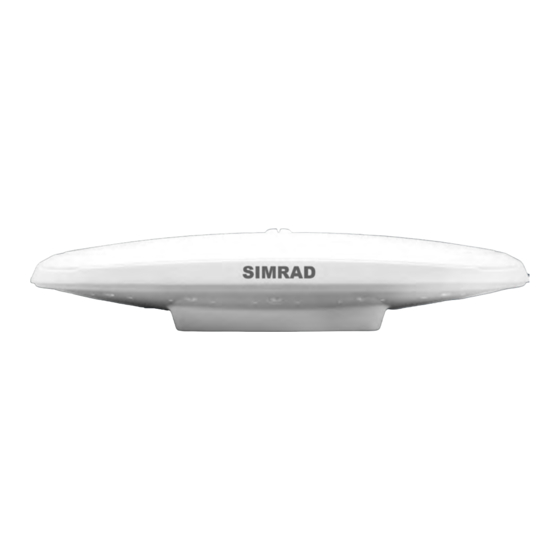
Table of Contents
Advertisement
Quick Links
Advertisement
Table of Contents

Summary of Contents for Simrad HS 75
- Page 1 ™ User manual English Scan here to save a copy www.navico-commercial.com...
- Page 3 Navico Group and other entities. • Navico is a trademark of Navico Group. ® • Simrad is a trademark of Kongsberg Maritime AS, licensed to Navico Group. ® • HS™ 75 is a trademark of Navico Group. •...
-
Page 4: Table Of Contents
CONTENTS 5 Introduction 5 Overview 5 Parts 6 Installation 6 Wiring guidelines 6 Mounting location 7 Mounting orientation 8 Mounting options 11 Wiring 12 Dimensions 13 Troubleshooting 14 Supported data 14 NMEA 2000 messages received based on a request ® 15 NMEA 2000 transmitted messages ® 17 Technical specifications... -
Page 5: Introduction
INTRODUCTION Overview The HS75 GNSS compass supports GPS, GLONASS, Galileo, QZSS, and BeiDou satellites. The HS75 GNSS antennas are separated by 20 cm (7.87”) between phase centers, resulting in a heading performance of better than 0.75° RMS. The HS75 can provide heading and positioning updates at 10 Hz and delivers positioning accuracy of 0.6 m 95% of the time when using differential GPS corrections from Satellite Based Augmentation Systems (SBAS). -
Page 6: Installation
INSTALLATION Wiring guidelines Before mounting the HS75, consider the following regarding the NMEA 2000 cable routing: ® • Avoid running the cable in areas of excessive heat. • Keep cable away from corrosive chemicals. • Do not run the cable through door or window jams. •... -
Page 7: Mounting Orientation
VHF interference VHF interference from cellular phones and radio transmitters may interfere with GNSS operation. VHF gain pattern GNSS gain pattern VHF antenna HS75 Minimum horizontal spacing: 2 m (6.5 ft). Minimum vertical spacing: 2 m (6.5 ft). Minimum cable separation: 0.3 m (1 ft) for the first 5 m (16.5 ft). Mounting orientation Mount the HS75 parallel to, and along the centerline of the axis of the boat. -
Page 8: Mounting Options
You can enter a heading offset from a compatible display unit. You will have an offset in the pitch/roll output if the unit is not installed on a horizontal plane. Alignment The top of the enclosure incorporates sight design features to help you align the enclosure with respect to the vessel. - Page 9 Surface mounting with adapter Secure the upper adapter to the HS75 using the supplied mounting hardware. Tighten to a torque of 11 - 13 Nm (8 - 10 lbs-ft). The maximum thread depth engagement must be no more than 12 mm (0.50“).
- Page 10 Pole mounting Screw the jam nut onto the 1-inch pole, then screw the pole mount bracket onto the pole. Do not tighten the pole mount to more than 5.4 Nm (4 lbs-ft). Feed the cable either through the hollow pole or through the opening in the pole mount bracket. Connect the NMEA 2000 drop cable to the HS75, then secure the pole mount bracket to the ®...
-
Page 11: Wiring
Wiring The HS75 has a standard NMEA 2000 Micro-C connector, used for both power and data ® communication. Purpose Shield NET-S (+12 V DC) NET-C (DC negative) NET-H NET-L Electrical isolation The HS75 power supply is isolated from the communication lines and the PC-ABS plastic enclosure isolates the electronics mechanically from the vessel (addressing the issue of vessel hull electrolysis). -
Page 12: Dimensions
DIMENSIONS 348.2 mm 158.4 mm (13.71 “) (6.23 “) 94.0 mm Qty. 4 - M8x1.25 - 12.7 (0.50 “) (3.70 “) -
Page 13: Troubleshooting
TROUBLESHOOTING Purpose Receiver fails to power • Verify the NMEA 2000 backbone is powered. ® • Check the voltage coming out of the connector at the end of the cable. • Check current restrictions imposed by power source (minimum available should be > 1.0 A). No data from the HS75 •... -
Page 14: Supported Data
SUPPORTED DATA NMEA 2000 messages received based on a request ® Description Default Freq (Hz) update rate (msec) 059392 ISO Acknowledgement On request On request Used to acknowledge the status of certain requests addressed to a specific ECU. 059904 ISO Request On request On request Request the transmission of a specific PGN, addressed... -
Page 15: Nmea 2000 ® Transmitted Messages
NMEA 2000 transmitted messages ® Description Default Freq (Hz) update rate (msec) 126992 System Time 1000 The purpose of this PGN is twofold: To provide a regular transmission of UTC time and date, and to provide synchronism for measurement data. 126993 Heartbeat 60000... - Page 16 129027 Position Delta, High Precision Rapid Update The ‘Position Delta, High Precision Rapid Update’ Parameter Group is for applications requiring high precision and very fast update rates for position data. This PGN provides delta position changes down to 1 mm with a delta time period accurate to 5 msec. 129028 Altitude Delta, High Precision Rapid Update The ‘...
-
Page 17: Technical Specifications
TECHNICAL SPECIFICATIONS Sensor and positioning accuracy Purpose Receiver type Vector sFreq GNSS Compass Signals received GPS, GLONASS, BeiDou, Galileo, QZSS1 Channels -142 dBm GPS sensitivity SBAS tracking 2-channel, parallel tracking (WAAS, EGNOS, MSAS) Update rate (position and heading) 10 Hz standard Positioning accuracy 1.2m RMS, (no SA) 0.3m RMS, (SBAS) - Page 18 Communication Purpose Connector NMEA 2000 Micro C ® Mechanical Purpose Weight (no mount) 0.75 kg Dimensions (no mount) L 34.8 cm x W 15.8 cm x H 6.5 cm L 13.7” x W 6.2” x H 2.6” Aiding devices Six-axis rate sensor (gyro) Provides smooth heading, fast heading reacquisition and reliable 1˚...
- Page 20 ®Reg. U.S. Pat. & Tm. Off, and ™ common law marks. Visit www.navico.com/intellectual-property to review the global trademark rights and accreditations for www.navico-commercial.com Navico Group and other entities.
















Need help?
Do you have a question about the HS 75 and is the answer not in the manual?
Questions and answers